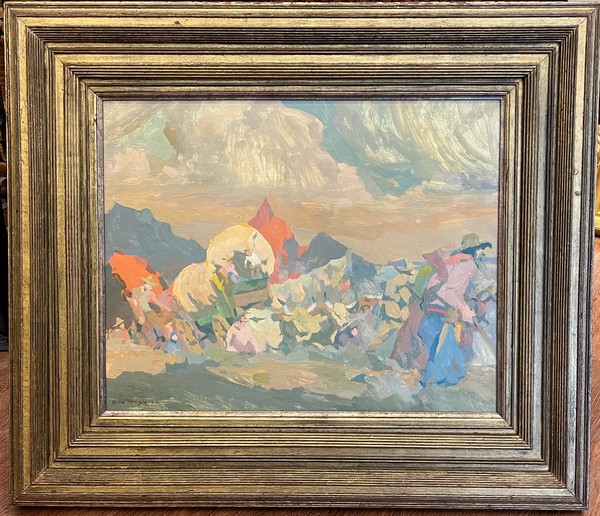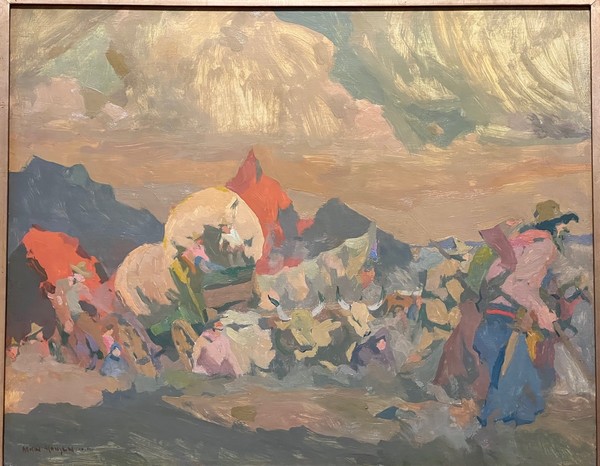Armin C. Hansen, N.A. (1886-1957)
View Artist Biography


Title:
"Empire Builders"
Date:
1936
Size:
15 3/4" 19 3/4"
Medium:
Oil on board
Signed:
Signed L.L.
Signed lower left
Titled and signed on reverse
One of two paintings that Hansen exhibited
at the CAA's 1936 Christmas Show.
A symbolic creation inspired by California’s Gold Rush era in the days of the Forty Niners
The "Empire Builders" is one of three significant paintings that Thelma B. Miller, art critic for the Carmel Pine Cone, singles out as a “new” method of painting which Armin Hansen briefly and very successfully ventured into in 1936.
The following is excerpted from: Jennie V. Cannon: The Untold History of the Carmel and Berkeley Art Colonies, Volume 1, East Bay Heritage Project, by Robert W. Edwards/2012, page 429:
In the summer of 1936, Hansen completed for the new library at Carmel's Sunset School his WPA Federal Art Project mural entitled 'The Span of Life', a symbolical creation in light, bright colors…'. That fall at the Carmel Art Association's Exhibition of Oils, Miller observed: The Hansen painting, 'With the Wind', seems to mark further the emergence of a new method by this outstanding artist. He has never made finer use of color than in some of his recent paintings. Of his two entries at the Carmel Art Association's Christmas Show in 1936 Miller found that one was a "blue-water" canvas in his "old method," but the other was executed in the new "symbolism which he is currently practicing" with "a whole new palette full of colors…his 'Empire Builders' inspired by the covered wagon period, but not historic or genre in style."
The following is excerpted from: Armin Hansen: The Artful Voyage by Scott A. Shields, PhD. / 2015:
"For decades, the American frontier symbolized the youth and potential of the new nation, but with development bridging the coasts and the country connected by iron rails and roads, the need to civilize the American wilds was waning, and the idea of the frontier was quickly becoming self-conscious, a sure sign that the era had passed. And yet the frontier did linger symbolically, making images and stories of humanity's interactions with nature appealing." Page 29.
CHRONOLOGY: December/1936: Exhibits two paintings (a blue marine and Empire Builders) in a show of small paintings at the Carmel Art Association. Page 251.
NOTE: Hansen painted a larger version of 'Empire Builders' in 1949, oil on canvas, 24” x 36”, commemorating the year of the Gold Rush. It is in the permanent collection of the Monterey Museum of Art.
Titled and signed on reverse
One of two paintings that Hansen exhibited
at the CAA's 1936 Christmas Show.
A symbolic creation inspired by California’s Gold Rush era in the days of the Forty Niners
The "Empire Builders" is one of three significant paintings that Thelma B. Miller, art critic for the Carmel Pine Cone, singles out as a “new” method of painting which Armin Hansen briefly and very successfully ventured into in 1936.
The following is excerpted from: Jennie V. Cannon: The Untold History of the Carmel and Berkeley Art Colonies, Volume 1, East Bay Heritage Project, by Robert W. Edwards/2012, page 429:
In the summer of 1936, Hansen completed for the new library at Carmel's Sunset School his WPA Federal Art Project mural entitled 'The Span of Life', a symbolical creation in light, bright colors…'. That fall at the Carmel Art Association's Exhibition of Oils, Miller observed: The Hansen painting, 'With the Wind', seems to mark further the emergence of a new method by this outstanding artist. He has never made finer use of color than in some of his recent paintings. Of his two entries at the Carmel Art Association's Christmas Show in 1936 Miller found that one was a "blue-water" canvas in his "old method," but the other was executed in the new "symbolism which he is currently practicing" with "a whole new palette full of colors…his 'Empire Builders' inspired by the covered wagon period, but not historic or genre in style."
The following is excerpted from: Armin Hansen: The Artful Voyage by Scott A. Shields, PhD. / 2015:
"For decades, the American frontier symbolized the youth and potential of the new nation, but with development bridging the coasts and the country connected by iron rails and roads, the need to civilize the American wilds was waning, and the idea of the frontier was quickly becoming self-conscious, a sure sign that the era had passed. And yet the frontier did linger symbolically, making images and stories of humanity's interactions with nature appealing." Page 29.
CHRONOLOGY: December/1936: Exhibits two paintings (a blue marine and Empire Builders) in a show of small paintings at the Carmel Art Association. Page 251.
NOTE: Hansen painted a larger version of 'Empire Builders' in 1949, oil on canvas, 24” x 36”, commemorating the year of the Gold Rush. It is in the permanent collection of the Monterey Museum of Art.

